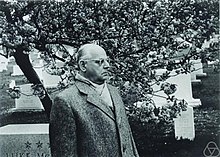|
Alexander Ostrowski
Alexander Markowich Ostrowski (Ukrainian: Олександр Маркович Островський; Russian: Алекса́ндр Ма́ркович Остро́вский; 25 September 1893 – 20 November 1986) was a mathematician. His father Mark having been a merchant, Alexander Ostrowski attended the Kiev College of Commerce, not a high school, and thus had an insufficient qualification to be admitted to university. However, his talent did not remain undetected: Ostrowski's mentor, Dmitry Grave, wrote to Landau and Hensel for help. Subsequently, Ostrowski began to study mathematics at Marburg University under Hensel's supervision in 1912. During World War I he was interned, but thanks to the intervention of Hensel, the restrictions on his movements were eased somewhat, and he was allowed to use the university library. After the war ended, Ostrowski moved to Göttingen where he wrote his doctoral dissertation and was influenced by Hilbert, Klein and Landau. In 1920, after having obtained his doctorate from the University of Göttingen,[1] Ostrowski moved to Hamburg where he worked as Hecke's assistant and finished his habilitation in 1922. In 1923, he returned to Göttingen and, in 1928, became Professor of Mathematics at Basel, until retirement in 1958. In 1950, Ostrowski obtained Swiss citizenship. After retirement, he still published scientific papers until his late eighties.
Selected publications
See alsoReferences
External links |
||||||||||||||||||
Portal di Ensiklopedia Dunia
